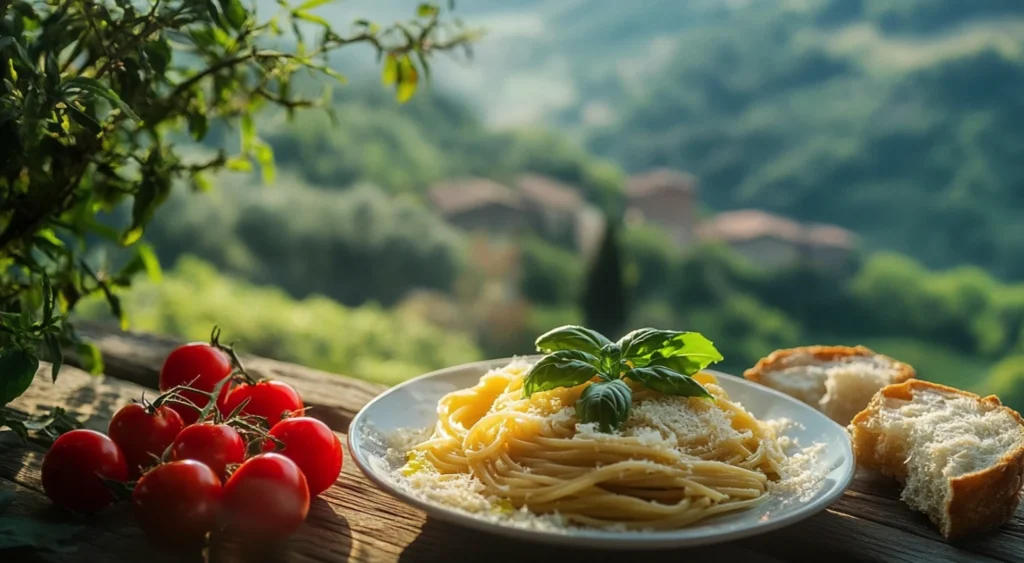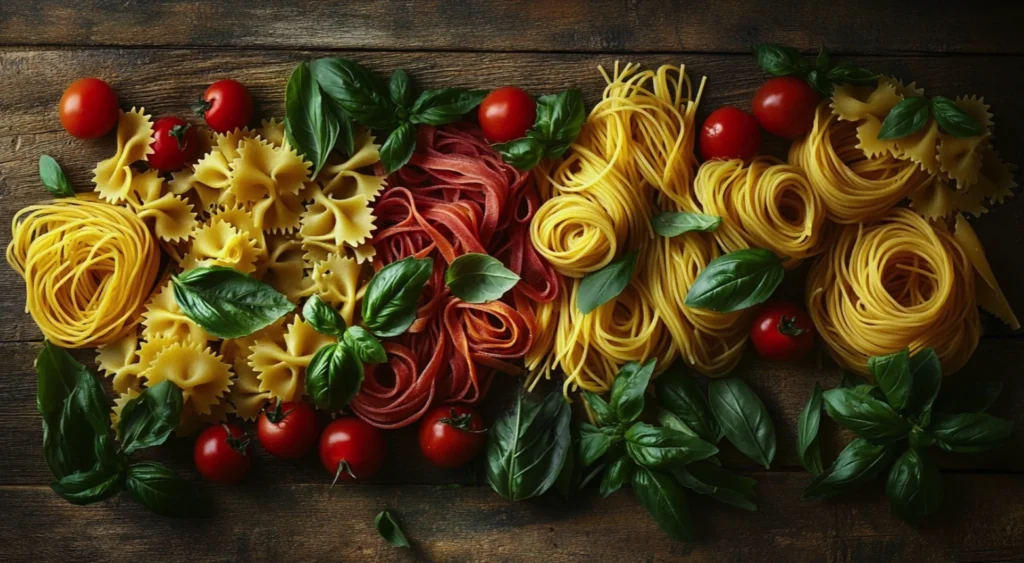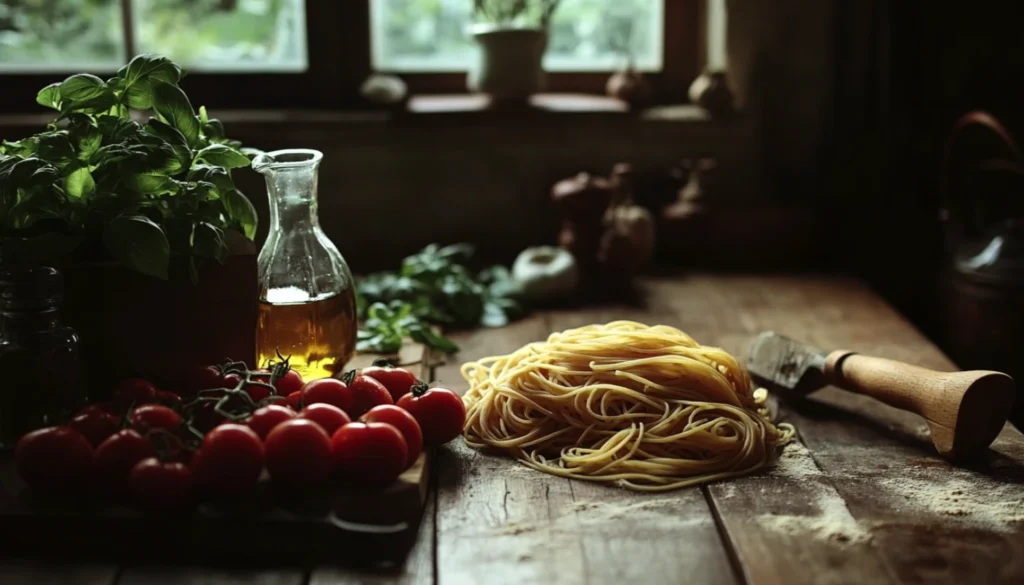love food, especially Italian dishes. The smells of fresh bread and the taste of perfect pasta take me to a special place. Italian Spaghettini Pasta is a key part of Italian cooking, showing elegance and grace in every bite
Spaghettini is thinner than spaghetti but just as tasty. It cooks fast and is great for quick meals. It’s perfect for anyone who loves pasta or wants to try something new.

A beautifully arranged plate of spaghettini pasta topped with fresh basil.
Table of contents
Key Takeaways
Spaghettini, a thinner version of traditional spaghetti, offers a delicate texture and cooks quickly. For example, many Italian households consider it a staple in their cuisine due to its versatility. Moreover, it pairs well with a wide range of sauces and toppings.
In particular, pasta lovers often choose spaghettini when they want a quick and delicious meal. The thin strands create a unique texture and enhance the overall eating experience. As a result, this pasta remains a favorite among Italian culinary delights.
Additionally, exploring spaghettini can introduce you to new flavors and cooking techniques. Therefore, it can enrich your Italian culinary adventures and provide a satisfying dining experience.
Introduction to Spaghettini: The Elegant Italian Long Pasta
Spaghettini is a long, thin pasta loved in Italy. It’s made from durum wheat and has a firm texture. It tastes subtly nutty and goes well with many sauces.
Spaghettini is thinner than spaghetti, with a diameter of 1.6-1.8 mm. This makes it great for light sauces. Spaghetti, being thicker, is better for heavy sauces.
| Pasta Shape | Diameter | Recommended Pairings |
|---|---|---|
| Spaghettini | 1.6-1.8 mm | Light, delicate sauces |
| Spaghetti | 1.9-2.1 mm | Hearty, robust sauces |
Spaghettini is good for many Italian dishes. It’s perfect for spaghetti carbonara and spaghettini alle vongole. It balances flavors well, making each bite enjoyable.
Spaghettini is great for both pasta lovers and newbies. It offers a refined dining experience. It shows the beauty of simple, yet delicious, Italian cooking.

An array of various pasta shapes.
The Art of Making Traditional Spaghettini Pasta
Making spaghettini pasta is a tradition in Italy. It uses special ingredients like semolina flour and durum wheat. These give spaghettini its unique taste and feel.
Traditional Ingredients and Methods
To make spaghettini, you mix semolina flour and water. The dough is then kneaded and pushed through bronze dies. This makes the pasta’s surface rougher.
This rough surface helps sauces stick better. It also makes the pasta taste more like it’s from the Old World.
Artisanal vs Commercial Production
Commercial pasta production uses steel dies and fast machines. But, making spaghettini by hand is different. It’s slower and more careful.
This way of making pasta makes it taste better and feel firmer. It’s a big difference from pasta made on a big scale.
Quality Indicators to Look For
- Rough, porous surface texture
- Vibrant, uniform color from high-quality semolina flour
- Firm, springy bite when cooked
- Absence of any artificial additives or preservatives
Knowing how spaghettini is made helps you find the best. You can enjoy its true taste and feel.

Nutritional Benefits of Spaghettini Pasta
Spaghettini is more than just a tasty Italian pasta. It has many health benefits when eaten as part of a balanced diet.
Spaghettini’s main nutritional value comes from its carbs. As a pasta, it’s full of carbohydrates. These carbs give us energy. But, they’re complex carbs, which means they give energy slowly and steadily.
It also has a lot of fiber. Eating just one serving gives you a big part of what you need every day. This fiber helps your digestion, keeps your bowels regular, and makes you feel full. This can help with weight control.
- Spaghettini is a source of complex carbohydrates that provide sustained energy.
- It contains a significant amount of dietary fiber, supporting digestive health and weight management.
- Spaghettini is a versatile and nutrient-dense pasta that can be incorporated into a balanced diet.
Eating spaghettini in moderation can be good for you. It’s full of carbs and fiber. These make it great for your health and well-being.
Perfect Cooking Techniques for Al Dente Spaghettini
Getting your spaghettini pasta just right is key to great Italian food. You need the right water-to-pasta ratio, timing, and temperature. Also, using salt and oil well makes a big difference.
Water-to-Pasta Ratio
The secret to perfect al dente spaghettini is the water-to-pasta ratio. Use about 4 to 6 quarts of water for every 1 pound of dry spaghettini. This much water lets the pasta cook evenly.
Timing and Temperature Control
Timing and temperature are crucial for the perfect al dente texture. First, boil the water, then add the spaghettini. Cook for 8 to 10 minutes, as the package suggests. Check the pasta often to get it just right.
Salt and Oil Usage Tips
- Put a good amount of salt in the boiling water to boost the pasta’s flavor.
- Drizzle some extra virgin olive oil into the water to stop the spaghettini from sticking.
By using these methods for cooking al dente spaghettini, you can make your dishes taste like Italy. Your family and friends will love every bite.
Classic Spaghettini Pasta Recipes and Pairings
Spaghettini is a true gem in Italian pasta dishes. Its slender strands pair well with many Italian recipes and sauce pairings. Let’s look at some classic spaghettini dishes that will make your taste buds happy.
Spaghettini alla Carbonara is a timeless Roman classic. It has a creamy sauce with eggs, guanciale, Pecorino Romano cheese, and black pepper. The spaghettini noodles are perfect for this rich dish.
Spaghettini alle Vongole is another favorite. It’s a seafood dish with spaghettini, clams, white wine, garlic, and parsley. It’s light yet full of flavor.
- Spaghettini alla Puttanesca is zesty and robust. It’s made with tomatoes, olives, capers, garlic, and anchovies.
- Spaghettini al Limone is bright and refreshing. It’s coated in a lemon sauce with cream and parsley.
- Spaghettini alle Vongole e Bottarga is luxurious. It combines clams with the taste of bottarga (cured fish roe).
Spaghettini’s delicate nature shines with many flavors. From lemon-based sauces to creamy carbonara, the choices are endless. Try different Italian recipes and see how versatile spaghettini is.
“Spaghettini is the epitome of simplicity and elegance in Italian cuisine. Its slender strands provide a canvas for the most delicious and diverse sauces.” – Chef Giada De Laurentiis
Storage and Preservation Methods
Keeping your spaghettini pasta fresh is key. Knowing how to store both dried and fresh pasta is important. It makes your Italian meals better.
Proper Storage Conditions
Store dried spaghettini in a cool, dry spot. A pantry or cupboard is best. Don’t let it get wet, hot, or sunny. This keeps it fresh for up to 2 years.
Fresh spaghettini needs extra care. Keep it cold in a sealed bag or container. This way, it stays good for 4-5 days.
Shelf Life Guidelines
- Dried spaghettini pasta: Up to 2 years when stored properly
- Fresh spaghettini pasta: 4-5 days when refrigerated
Handling Fresh vs. Dried Pasta
Be gentle with fresh spaghettini. Don’t twist it too much. Just a soft toss in sauce is enough. Dried pasta can handle more stirring.
| Characteristic | Fresh Spaghettini | Dried Spaghettini |
|---|---|---|
| Storage Conditions | Refrigeration | Cool, dry place |
| Shelf Life | 4-5 days | Up to 2 years |
| Handling | Gentle tossing | Robust handling |
Learning how to store and keep both fresh and dried pasta storage right is crucial. It helps your spaghettini dishes stay fresh and tasty every time.
Common Cooking Mistakes to Avoid
Making a tasty spaghettini pasta dish is more than just following a recipe. It’s about avoiding common mistakes. These mistakes can ruin the al dente texture and flavors. As a professional copywriter, I’ll share common mistakes and how to fix them for perfect al dente spaghettini.
One big mistake is overcooking the pasta. Spaghettini should be al dente, firm but not hard. Overcooking makes it mushy and bad-tasting.
- Watch the cooking time closely and test the pasta often.
- Use the package instructions as a guide, but adjust based on your taste.
Another mistake is undercooking. Undercooked spaghettini is hard and not good to eat. It’s important to find the right balance.
- Try the pasta a few minutes before it’s done to see if it’s right.
- If it’s too hard, cook it a bit longer, checking every minute or two.
Also, not using the sauce right can mess up the dish. Spaghettini needs to be well-coated with sauce for great flavor and texture.
| Common Mistake | Solution |
|---|---|
| Overcooking pasta | Monitor cooking time and test for al dente texture |
| Undercooking pasta | Taste and adjust cooking time as needed |
| Improper sauce application | Ensure pasta is thoroughly coated with the sauce |
Avoid these mistakes to make amazing al dente spaghettini. With practice and attention, you’ll get better at making pasta dishes that wow everyone.
Conclusion
We’ve looked into the world of spaghettini pasta in this article. We found out about its history, tasty flavors, and its big role in Italian cuisine. We learned how it’s made and how it makes many pasta dishes better.
If you love pasta or are new to spaghettini pasta, keep trying new recipes. Use it with your favorite sauces, veggies, and meats. This way, you’ll make dishes that taste like Italy.
Exploring spaghettini pasta means using the best ingredients and cooking right. Enjoy every bite. This will make your meals better and help you love Italian food more.
FAQ
What is spaghettini pasta?
Spaghettini is a thin, long pasta from Italian cuisine. It’s like spaghetti but thinner. This makes it delicate and elegant.
How does spaghettini differ from regular spaghetti?
Spaghettini is thinner than regular spaghetti. It’s about 1.6 to 2 millimeters thick. Regular spaghetti is a bit thicker, around 1.9 to 2.2 millimeters. This makes spaghettini feel more delicate when you eat it.
What are the benefits of cooking with spaghettini?
Cooking with spaghettini is great for a few reasons. It cooks fast, perfect for quick meals. It also goes well with light sauces, letting the flavors stand out. Plus, its look and feel are great for fancy dishes.
What are the key ingredients in traditional spaghettini pasta?
Real spaghettini is made from semolina flour. This flour comes from durum wheat. The flour and water mix is then shaped into the long, thin strands of spaghettini.
How can I tell if spaghettini is high-quality?
Look for spaghettini made from 100% semolina flour. It should be the same thickness all over. It should feel smooth and look golden. Avoid pasta that looks dull or has uneven thickness.
What is the best way to cook spaghettini pasta?
To cook spaghettini right, boil a big pot of salted water. Add the pasta and cook for 7-10 minutes. Stir it a bit until it’s al dente. Don’t overcook it. Drain and toss with your favorite sauce right away.
What are some classic spaghettini pasta dishes?
Spaghettini goes well with many sauces. Try it with clams, carbonara, or lemon sauce. It’s also good with pesto or tomato sauce.
How should I store spaghettini pasta?
Keep dried spaghettini in a cool, dry place. Use an airtight container. For fresh spaghettini, use it within a few days. Store it in the fridge in its original packaging or an airtight container.

